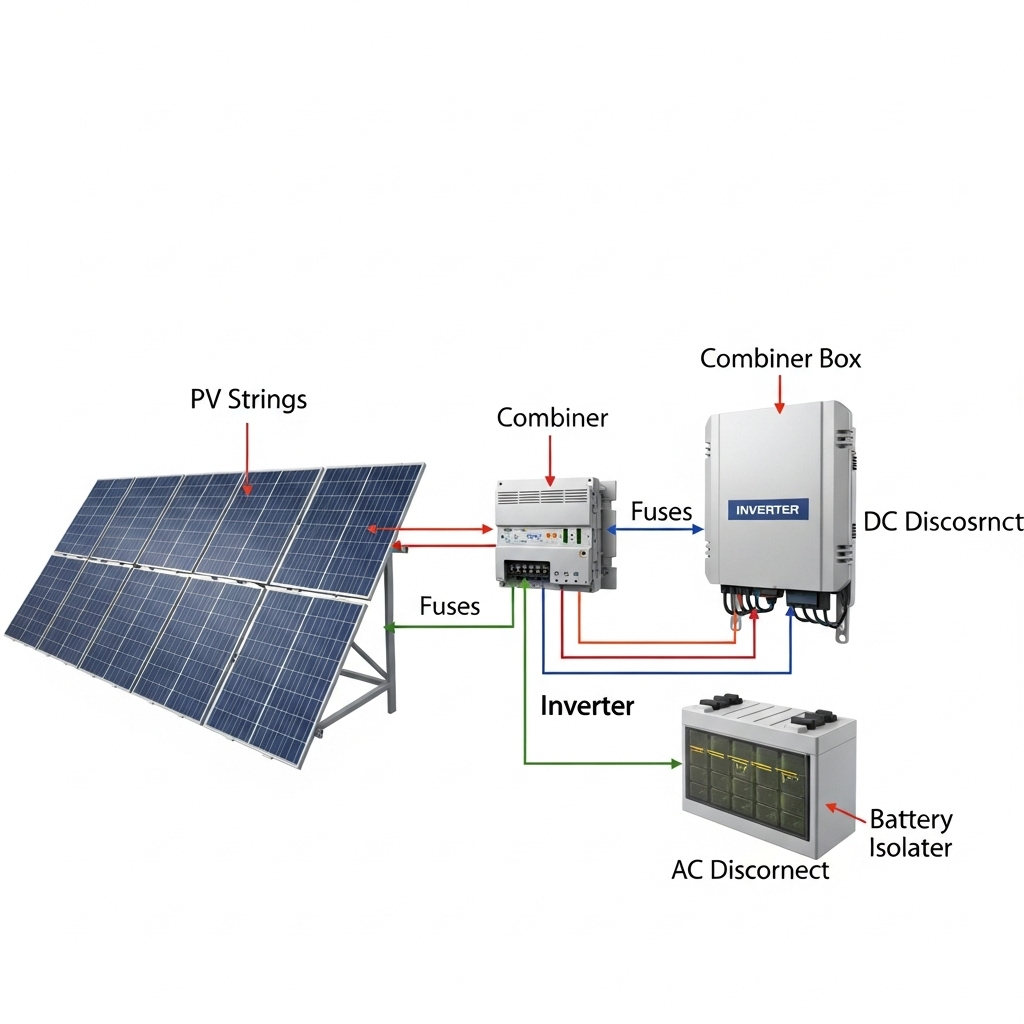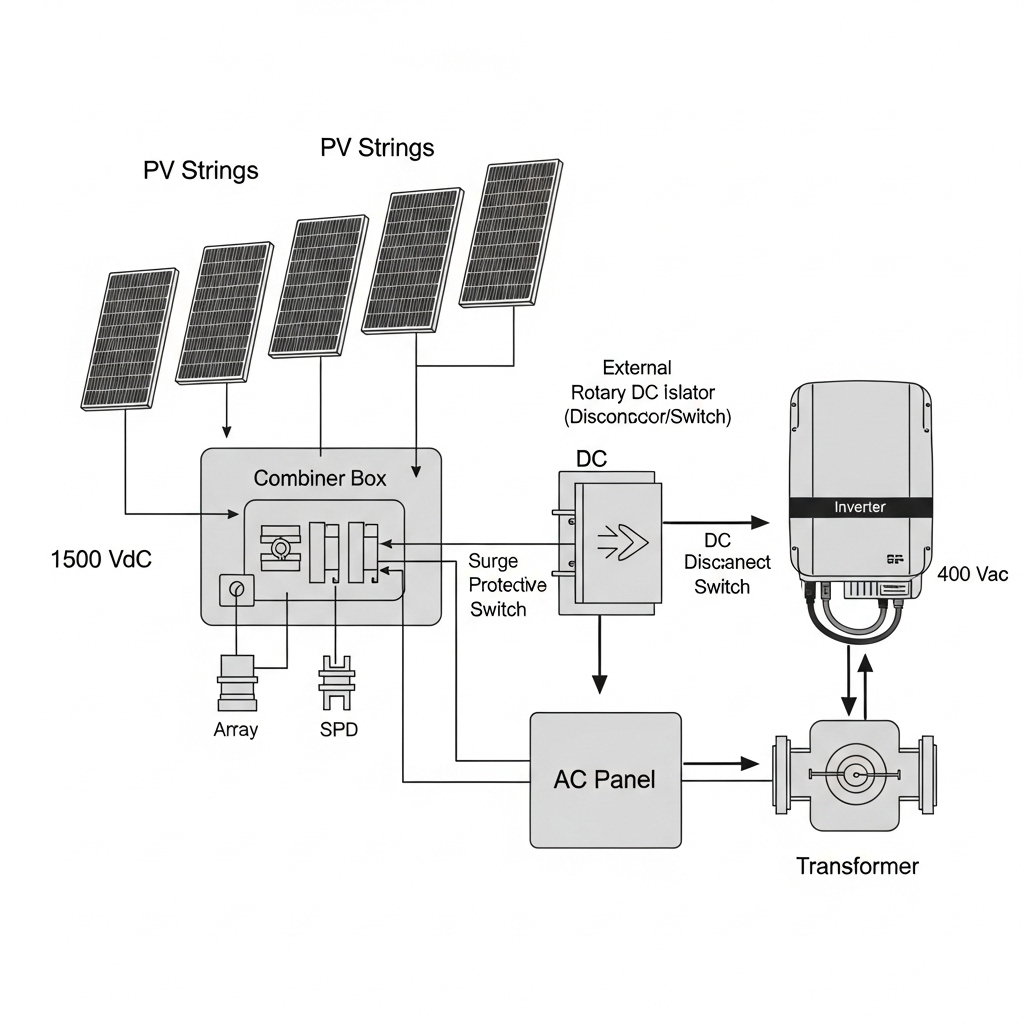When planning a solar energy system, much of the focus goes to the major components like panels, inverters, and batteries. However, a set of critical wiring safety devices ensures the system operates safely and efficiently. Combiner boxes, isolator switches, and disconnects are the traffic controllers of your solar array. They manage the flow of power, provide vital protection, and allow for safe maintenance. Understanding their roles is fundamental to building a reliable and long-lasting solar and storage solution.
This article offers a clear overview of these components. You will learn what they do, why they are necessary, and how they fit into residential, commercial, and off-grid solar applications.
The Combiner Box: The Junction Point of Your Solar Power
Think of a combiner box as a junction point for your solar panels. It streamlines the wiring from multiple solar panel strings into a single, more manageable circuit before it heads to the inverter.
What is a PV Combiner Box and Why Do You Need One?
A PV combiner box takes the output from several strings of solar panels and combines them into one main feed. For any system with more than three strings, a combiner box is a practical necessity. It simplifies the wiring going to the inverter, which can reduce material and labor costs. By organizing the connections in one enclosure, it also provides a centralized location for safety and protection devices. This organization is not just for convenience; it is a core part of an efficient system design that minimizes potential power loss and simplifies troubleshooting. For a complete overview, see the Ultimate Guide: PV Combiner Boxes, Isolators, Disconnects.
Key Components Inside a Combiner Box
A standard combiner box is more than just an empty enclosure. It houses several critical components that protect your entire solar investment:
- Fuses or Circuit Breakers: Each solar string connects to a fuse or a circuit breaker inside the box. These devices provide overcurrent protection, interrupting the circuit if the current exceeds a safe level, which can prevent damage to your panels and inverter. Correctly sizing these components is a critical step in system design, as explored in How to size fuses and disconnects in PV combiner boxes.
- Bus Bars: These are conductive metal bars that aggregate the current from all the individual strings into a single output circuit.
- Disconnect Switch: Many combiner boxes include an integrated disconnect switch, allowing you to manually shut off the power from the solar array for maintenance or emergencies.
- Surge Protection Devices (SPDs): An optional but highly recommended feature, SPDs protect your system from voltage spikes caused by lightning or grid fluctuations. To make an informed choice, consult the Buyer's checklist: IP rating, surge, and arc-fault in combiners.
Real-World Combiner Box Applications
Combiner boxes are versatile and used across all scales of solar installations. In residential rooftop systems, they provide a neat and safe way to manage a handful of strings. For larger commercial and utility-scale projects, multiple combiner boxes are used to manage vast arrays, often incorporating advanced monitoring hardware. In off-grid solar solutions, they are indispensable for organizing the power flow from the array to the charge controller and battery bank, forming the backbone of a reliable energy system for homes, farms, or cabins. The integration of intelligent features can further reduce operational risks, as detailed in the Case Study: Smart combiners cut O&M risk in hybrid ESS.
Isolator and Disconnect Switches: Your System's Safety Controls
While often used interchangeably, isolators and disconnects serve distinct but related safety functions. Both are designed to interrupt the flow of electricity, but they operate under different conditions and provide different levels of protection.
The Critical Role of a Disconnect Switch
A disconnect switch is a manually operated switch designed to completely de-energize a circuit for service or maintenance. According to the National Electrical Code (NEC), a readily accessible disconnect is required for most PV systems. These switches are placed at key points, such as between the solar array and the inverter (DC disconnect) and between the inverter and the electrical panel (AC disconnect). This allows a technician to safely work on a component like an inverter without the risk of electrical shock from the panels or the grid. For hybrid systems, choosing the correct type is vital; learn more at AC vs DC disconnects: choosing safely for hybrid inverters.
Understanding the Isolator Switch
An isolator switch provides a means of safely isolating a part of the electrical system. Its primary job is to guarantee that a circuit is de-energized and will remain so while work is being performed. Unlike a circuit breaker, an isolator is generally not intended to interrupt a circuit under load or fault conditions. It is operated manually after the current has been stopped by other means. In many regions, regulations have specific requirements for isolators, such as rooftop DC isolators, to provide emergency responders with a way to shut down the array. For more on code compliance, review the Blueprint: rapid shutdown, combiner isolation, code compliance and Are rooftop DC isolators still required under IEC/NEC?.
Common Issues and Failure Modes
Despite their simple appearance, these devices can fail. Common problems include water ingress from improper sealing, corrosion of terminals, loose connections, and mechanical failure from repeated use or environmental exposure. These issues can lead to dangerous conditions like arc faults or system downtime. Proper installation is the first line of defense against these problems. You can learn about what to avoid in Seven wiring mistakes in PV combiner boxes and isolators. For a deeper analysis of component failures, see the Data insight: failure modes in PV disconnects and isolators.
Selecting and Integrating the Right Components
Choosing the right components involves more than just matching the brand of your inverter. It requires careful consideration of your system's electrical characteristics and environmental conditions.
Sizing and Specification: A Numbers Game
Properly sizing your combiner box, isolators, and disconnects is critical for safety and performance. Key parameters include:
- Voltage Rating: The component must be rated to handle the maximum system voltage (Voc) of your solar array.
- Current Rating: It must be able to handle the maximum current (Isc) from the combined strings, with a safety factor applied.
- Enclosure Rating: The enclosure must be rated for the environment where it will be installed. This is often indicated by an IP (Ingress Protection) or NEMA rating.
| IP Rating | Protection Against Solids | Protection Against Liquids | Common Use Case |
|---|---|---|---|
| IP65 | Dust tight | Protected against water jets from any direction | Outdoor locations exposed to rain and dust |
| IP67 | Dust tight | Protected against temporary immersion in water | Areas with potential for temporary flooding |
| IP68 | Dust tight | Protected against continuous immersion in water | Submersible applications (rare for these components) |
The Rise of "Smart" Combiners and Monitoring
Modern "smart" combiner boxes integrate monitoring hardware that can track the performance of each individual string. This provides valuable data for troubleshooting, helping to quickly identify underperforming panels or wiring issues. While these devices offer powerful insights, it's important to understand their capabilities and limitations. They provide data, but don't automatically fix problems. Explore this topic further in Myth vs Reality: "Smart" combiner boxes monitor everything. The future of this technology points towards even greater integration and data analytics, as discussed in the 2025 trend forecast: digital combiner boxes and analytics.
Integration with Energy Storage Systems (ESS)
In a system that includes energy storage, these safety devices are even more important. They are needed to safely isolate the high-performance LiFePO4 battery bank, the hybrid inverter, and the solar array from one another during installation and maintenance. In an integrated home energy storage system, every component works together. Reliable disconnects and combiners are foundational to the safety and longevity of the entire solution, ensuring that the power generated by your solar panels is managed safely as it flows to the inverter or charges your lithium batteries. The efficiency of this energy transfer is a key factor in overall system output, a topic covered in the ultimate reference on solar storage performance.
Beyond the Basics: A Foundation for Reliability
Combiner boxes, isolators, and disconnects are more than just plastic boxes with switches. They are fundamental components that provide safety, enhance system efficiency, and simplify maintenance. Selecting high-quality, properly rated devices and ensuring they are installed correctly is a crucial step toward achieving energy independence. A well-built solar and storage system relies on these components to safely manage the power you generate for years to come.
Disclaimer: This article is for informational purposes only and does not constitute professional electrical or financial advice. Always consult with a qualified professional for system design and installation.





Leave a comment
All comments are moderated before being published.
This site is protected by hCaptcha and the hCaptcha Privacy Policy and Terms of Service apply.